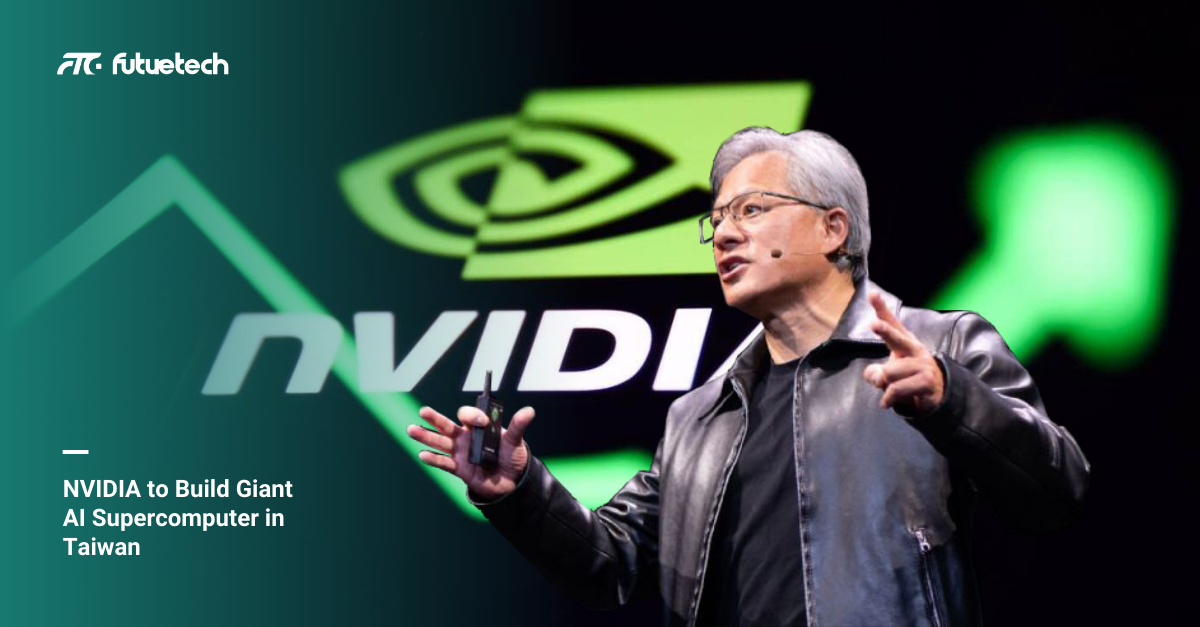
Taipei, May 26, 2025 — During the opening keynote of Computex 2025, NVIDIA CEO Jensen Huang unveiled a series of major announcements that reaffirm the company’s aggressive push in artificial intelligence computing and infrastructure.
Among the highlights was NVIDIA’s plan to build Taiwan’s first AI supercomputer, developed in partnership with key local players such as TSMC and Foxconn. This move marks a significant step in strengthening Taiwan’s AI capabilities and building a robust local ecosystem to support the next wave of intelligent technologies.
NVIDIA to Build AI Infrastructure in Taiwan with Local Industry Leaders
Huang announced that NVIDIA will collaborate with Taiwanese semiconductor foundry TSMC and electronics manufacturing giant Foxconn to construct a state-of-the-art AI supercomputing platform in Taiwan. The initiative aims to provide a strong foundation for advanced AI development, model training, and industry applications across the region.
“This will be a pivotal project for the future of AI innovation in Taiwan,” Huang said. “We’re building an infrastructure that can empower researchers, developers, and enterprises to unlock the potential of generative AI.”
This collaboration underscores the increasingly critical role of regional AI infrastructure in enabling localized innovation and reducing dependence on foreign computing resources.
Introducing NVIDIA Constellation: A Futuristic Campus in Taiwan
Another major highlight of the keynote was the introduction of a new NVIDIA regional campus in Taiwan, which will be named NVIDIA Constellation. The architectural rendering presented during the speech revealed a futuristic design that resembles a spacecraft, symbolizing technological aspiration and innovation.
According to Huang, the campus will serve as a regional hub for R&D, corporate operations, and collaboration with local partners. Construction is expected to begin soon, with the facility designed to offer a highly functional and forward-looking workspace for employees.
The Evolution of DGX: From Cloud-Scale to Personal AI Supercomputing
NVIDIA’s journey in AI supercomputing began in 2016 with the introduction of the DGX-1 system. This pioneering hardware platform, which was notably donated to OpenAI by Huang himself, played a crucial role in accelerating early AI research efforts.
Since then, the DGX product line has continuously evolved—introducing more powerful, scalable systems such as DGX-2, DGX A100, and DGX H100. In March 2025, NVIDIA took another leap forward with the introduction of DGX Spark and DGX Station, systems designed to bring AI supercomputing directly to individuals and small teams.
At today’s keynote, Huang confirmed that DGX Spark has entered full production and will be available in the coming weeks. The system allows AI practitioners to train complex models from a desktop setup, bridging the gap between cloud-scale performance and personal accessibility.
In addition, DGX Station, also launched in March, is designed for plug-and-play AI computing. Huang noted that it runs on standard wall power and can even be deployed in non-traditional settings like home offices or creative studios—while still supporting models with up to one trillion parameters.
Expanding U.S. Manufacturing for AI Hardware
NVIDIA is also scaling up its manufacturing capacity in the United States. On April 14, the company announced the establishment of a network of facilities designed to locally build NVIDIA’s AI supercomputing systems.
In Arizona, NVIDIA has activated over one million square feet of space to test and assemble the next-generation Blackwell chips. These chips form the computational core of NVIDIA’s future DGX systems and are being manufactured at TSMC’s advanced wafer fab in Phoenix.
Meanwhile, new AI system assembly lines are being developed in Texas. In Houston, NVIDIA is working with Foxconn to build system-level manufacturing capabilities, while in Dallas, it has partnered with Wistron to establish an additional AI system integration site. Both facilities are expected to ramp up production over the next 12 to 15 months.
To complete the supply chain, NVIDIA will collaborate with Amkor Technology and SPIL for chip packaging and testing in Arizona—ensuring comprehensive in-country manufacturing across all stages.
Deepening Ties with China Amid Global Expansion
While NVIDIA expands in the U.S. and Taiwan, it is also reinforcing its commitment to the Chinese market. On April 17, Jensen Huang visited both Beijing and Shanghai, where he met with partners and stakeholders to explore continued collaboration opportunities.
This follows earlier statements Huang made earlier this year during a previous trip to China, where he reiterated the company’s intention to maintain strong engagement with local customers and support AI development in the region.
China remains a significant market for NVIDIA, not only in terms of hardware sales but also as a hub for AI research, data centers, and application development.
A Strategic Blueprint for Global AI Infrastructure
NVIDIA’s recent moves illustrate a clear and coordinated strategy: to decentralize AI capacity, enable innovation at the edge, and support rapid growth in enterprise and consumer AI.
● In the U.S.: Local production of AI systems, with an end-to-end supply chain based in Arizona and Texas.
● In Taiwan,China: A full-scale supercomputer initiative and the creation of the futuristic Constellation campus.
● In China: Continued business engagement, product deployment, and ecosystem partnerships.
● Globally: Rolling out DGX platforms, AI tools, and software frameworks to accelerate adoption across sectors.
Rather than operating as a pure chip vendor, NVIDIA is increasingly positioning itself as a global provider of AI computing platforms—offering solutions that span from hardware and middleware to developer tools and cloud services.
A New Chapter: Lighting Up the AI Constellation
The naming of NVIDIA’s Taiwan campus as “Constellation” is more than symbolic. It reflects the company’s vision of a globally interconnected AI infrastructure—where powerful computing nodes, advanced chips, and creative minds work together across borders.
As NVIDIA continues to release innovative systems like DGX Spark and scale manufacturing through the Blackwell chip platform, its investments are shaping the future of artificial intelligence from the ground up.
This next chapter in AI development is not just about performance or scale—it’s about accessibility, sustainability, and building a global constellation of innovation.



